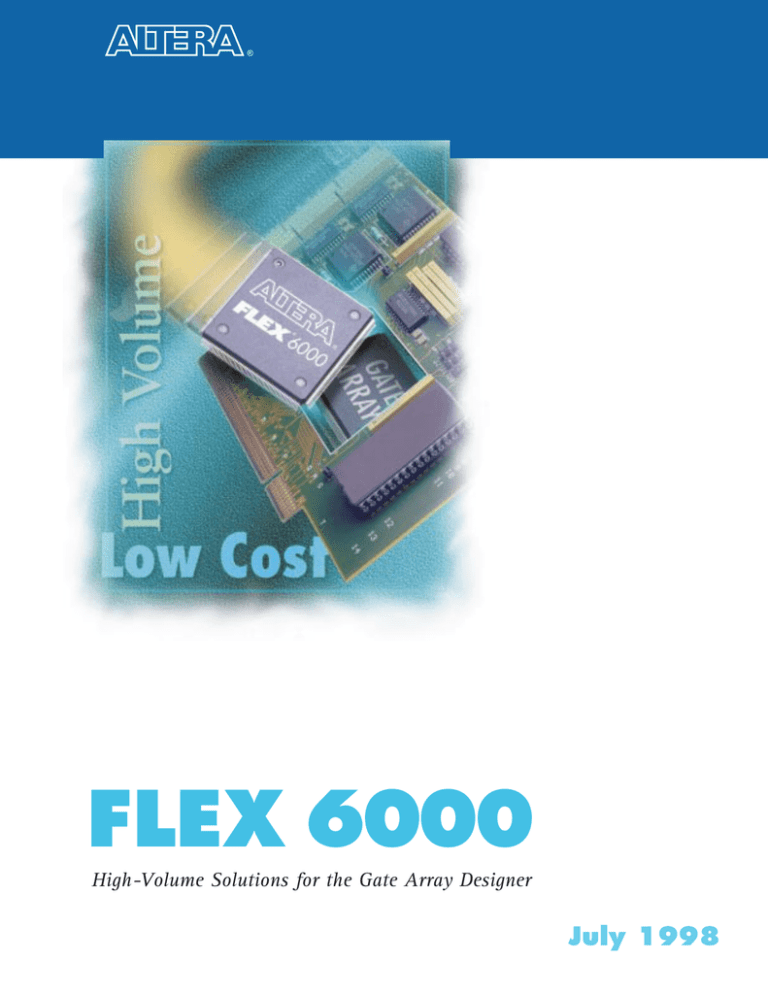
®
FLEX 6000
High-Volume Solutions for the Gate Array Designer
July 1998
P
Programmability at Gate Array Prices
Altera’s FLEX® 6000 programmable logic device (PLD)
family delivers the flexibility and time-to-market of
programmable logic at prices that are competitive with
gate arrays. Featuring the OptiFLEX™ architecture, the
industry’s most efficient architecture, FLEX 6000 devices
provide a flexible, high-performance, and cost-effective
alternative to ASICs for high-volume production.
FLEX 6000 OptiFLEX Efficiency
Relative Die Size Comparison
1.0
1.06
Gate Array
0.5 µ
240 Pins
FLEX 6000
0.5 µ
240 Pins
FLEX 6000 Devices
EPF6010A
EPF6016
EPF6016A
EPF6024A
Process Geometry
0.35 µ
0.5 µ
0.35 µ
0.35 µ
Supply Voltage
3.3 V
5.0 V
3.3 V
3.3 V
Yes
Yes
Yes
Yes
FEATURE
Pin Migration
5,000 - 10,000 8,000 - 16,000 8,000 - 16,000 12,000 - 24,000
Gate Count
880
Logic Elements
139
204
171
218
144-pin TQFP
208-pin PQFP
240-pin PQFP
256-pin BGA
100-pin TQFP
100-pin BGA*
144-pin TQFP
208-pin PQFP
256-pin BGA*
144-pin TQFP
208-pin PQFP
240-pin PQFP
256-pin BGA
256-pin BGA*
* FineLine BGA™ package
Today’s ASIC designers realize that low cost and time-tomarket are critical for market success. In the past,
designers were forced to make a tradeoff: use programmable logic for flexibility or use ASICs for low unit cost.
But the FLEX 6000 family eliminates this tradeoff by
providing low-cost, high-performance flexibility from
initial prototyping through volume production.
FLEX 6000 Redefines PLD Pricing
Relative Unit Cost
3X
2X
®
PLD
1X
Gate Array
1996
1997
1998
OptiFLEX Redefines Programmable Logic Efficiency
Built on either a 3.3-V, 0.35-µ or 5.0-V, 0.5-µ, triplelayer-metal CMOS process, the SRAM-based FLEX 6000
family features the efficient OptiFLEX programmable logic
architecture. Every feature in the OptiFLEX architecture is
targeted at producing maximum performance and
utilization in the smallest possible die area.
Altera Corporation
Source: Altera
1,960
100-pin TQFP
100-pin BGA*
144-pin TQFP
256-pin BGA*
User I/O Pins (max.)
Package Options
1,320
1,320
The FLEX 6000 logic array contains logic array blocks
(LABs) composed of 10 logic elements (LEs) that communicate through a fully populated local interconnect
structure. This LAB has been designed to support LAB
interleaving, an innovative feature that gives any LE the
flexibility to access the local interconnect of its own LAB
as well as adjacent LABs. LAB interleaving leverages the
inherent speed and flexibility of local resources while
optimizing global row and column resource utilization
within the FLEX architecture.
Each LE contains a four-input look-up table (LUT), a programmable register, and dedicated paths for carry and
cascade functions. The logic array is routed through
Altera’s patented FastTrack Interconnect™, a series of fast,
continuous row and column channels that run the entire
length and width of the device. Each FastTrack row and
column feeds multiple I/O elements (IOEs), which have a
programmable slew-rate and an individual tri-state output
enable control for each pin. The FLEX 6000 family also
supports FastFLEX™ I/O, a feature that provides a direct
path from the LE to the I/O pin for fast clock-to-output
timing and helps meet stringent PCI timing requirements.
Maximum Die Size Reduction with µPitch
Bond Pad Technology
To support costs competitive with gate arrays, Altera
combined the OptiFLEX architecture with an advanced
75-µ bond pad pitch. This combination of architecture
optimization and µPitch™ bond pad technology
maximizes silicon efficiency, producing a FLEX 6000 die
size that is competitive with that of gate arrays.
Low Cost without Sacrificing Performance
Due to the limitations of a segmented architecture,
FPGAs must sacrifice both performance and utilization
for cost. However, FLEX 6000 devices do not have this
constraint. The OptiFLEX architecture optimizes both
logic and routing resources while maintaining high performance and utilization. The key is Altera’s patented
FastTrack Interconnect. By combining interleaved LABs
and FastFLEX I/O with a predictable, continuous
interconnect structure, FLEX 6000 devices offer higher
performance than FPGAs at a significantly lower price.
Flexible Pin Migration
Each FLEX 6000 device is footprint-compatible with
other devices in the same package, thus maximizing
productivity by supporting concurrent HDL design and
board layout. Designs that grow beyond the capacity of a
device can easily be migrated to a larger device without
requiring a board re-spin. This feature also enables the
designer to use a larger device for easy prototyping while
maintaining the flexibility to optimize the production
design to fit smaller, less-expensive, pin-compatible
devices.
System-Level Features
The FLEX 6000 family contains a number of powerful
system-level features that boost design efficiency:
FLEX 6000 Performance*
BENCHMARK
LEs -1 SPEED -2 SPEED -3 SPEED
USED GRADE
GRADE
GRADE
16-bit loadable counter
16
140 MHz
131 MHz
109 MHz
16-bit accumulator
16
140 MHz
131 MHz
109 MHz
24-bit accumulator
24
108 MHz
103 MHz
86 MHz
16-to-1 multiplexer (pin-to-pin)
10
10.5 ns
11.7 ns
15.5 ns
16 x 16 multiplier, 4-stage pipeline
592
78 MHz
69 MHz
59 MHz
8-bit, 16-tap parallel finite
impulse response (FIR) filter
599
94 MSPS
81 MSPS
67 MSPS
8-bit, 512-point fast Fourier
transform (FFT)
1,182
75 µS
62 MHz
87 µS
54 MHz
109 µS
43 MHz
a16450 universal asynchronous
receiver/transmitter (UART)
468
36 MHz
30 MHz
25 MHz
PCI bus target with zero wait states
601
62 MHz
52 MHz
39 MHz
* Designs implemented in EPF6016A device and compiled using Altera
MAX+PLUS® II version 9.0 software.
■
■
■
■
■
In-circuit reconfigurability (ICR) is available via an
external Configuration EPROM or intelligent controller
Devices are fully compliant with the peripheral
component interconnect (PCI) standard
Built-in JTAG boundary-scan testing (BST) circuitry
simplifies device- and system-level testing
MultiVolt™ I/O interface makes FLEX 6000 devices
ideal for 2.5-, 3.3-, and 5.0-V mixed-voltage systems
One output enable per I/O pin supports flexible
interrupt structures
FLEX 6000 Architecture
FastTrack Interconnect
FastFLEX I/O
FLEX 6000 Die
Column
Interconnect
Row Interconnect
(not shown to scale)
Pin
Pin
Interleaved LABs
Column
Interconnect
Row Interconnect
Local
Interconnect
µPitch Technology
2.96 mil (75 µm)
Local
Interconnect
Bond Pads
Altera Corporation
®
Placement & Routing Efficiency with
Fast Compilation Times
To help you quickly design with FLEX 6000 devices,
Altera offers the most powerful, flexible, and easy-to-use
development tools in the industry. The MAX+PLUS® II
development software leverages the efficiency of the
OptiFLEX architecture by offering the most automatic
and sophisticated placement and routing algorithms. This
combination of efficient device architecture and intelligent software algorithms allows the system designer to
achieve desired place and route results within a matter of
minutes while using a high percentage of the device’s
resources.
Design Flow Integration
MAX+PLUS II can exchange netlists in EDIF, VHDL, or
Verilog HDL formats, providing a convenient interface to
industry-standard EDA tools. Through the Altera
Commitment to Cooperative Engineering Solutions
(ACCESS ) program, Altera supports design entry, synthesis, and simulation tools from all major EDA vendors,
allowing FLEX 6000 devices to be integrated seamlessly
into a designer’s existing design environment.
SM
Megafunction and Intellectual Property Support
To maximize design productivity, Altera provides
complex system-level functions that are optimized for
the FLEX 6000 architecture. Altera’s MegaCore™ functions are developed, pre-tested, and licensed by Altera,
providing customers with functions for PCI, UARTs, FFTs
and more. Megafunctions are also offered through the
Altera Megafunction Partners Program (AMPP ), an
FLEX 6000 Routing Efficiency
100%
100%
90%
Probability of
Successful Fit
61-70%
71-80%
81-90%
Device Usage
(% of Total Logic Cells Used)
alliance between Altera and developers of synthesizable
megafunctions. The AMPP alliance provides a broad
portfolio of Altera-optimized megafunctions that
facilitate high-density design.
FLEX 6000: Low Cost. Flexible. Fast Time-to-Market.
The FLEX 6000 family of programmable logic devices
provides designers with a programmable alternative to
gate arrays for high-volume production. With the
industry’s most efficient architecture—the OptiFLEX
architecture—the Altera FLEX 6000 family delivers the
flexibility and time-to-market of programmable logic at
prices that are competitive with gate arrays.
Call Altera today or visit the web site at
http://www.altera.com to learn more about how the
FLEX 6000 family can provide low-cost flexibility for
your volume production needs.
SM
Altera Offices
Corporate Headquarters
Altera Corporation
101 Innovation Drive
San Jose, CA 95134
USA
Telephone: (408) 544-7000
http://www.altera.com
Altera European Headquarters
Altera U.K. Limited
Holmers Farm Way
High Wycombe
Buckinghamshire
HP12 4XF
United Kingdom
Telephone: (44) 1 494 602 000
Altera Japan Limited
Shinjuku Mitsui Building 36F
1-1, Nishi-Shinjuku, 2 Chome
Shinjuku-ku, Tokyo 163-04
Japan
Telephone: (81) 3 3340 9480
http://www.altera.com/japan
Altera International Limited
Suite 908-920, Tower 1
Metroplaza
223 Hing Fong Road
Kwai Fong, New Territories
Hong Kong
Telephone: (852) 2487 2030
Copyright © 1998 Altera Corporation. Altera, ACCESS, AMPP, ClockLock, ClockBoost, FastFLEX, FastTrack Interconnect, FLEX, FLEX 6000, MAX+PLUS,
MAX+PLUS II, MegaCore, MultiVolt, OptiFLEX, µPitch, The Altera Advantage, and specific device designations are trademarks and/or service marks of Altera
Corporation in the United States and other countries. Other brands or products are trademarks of their respective holders. The specifications contained herein
are subject to change without notice. All rights reserved.
M-GB-F6K-03


